Article's Content
The other day, while scrolling through a list of major IPOs from 2021, I came across a successful launch that really caught me by surprise.
Toast — an all-in-one restaurant management and point-of-service platform — went public in September 2021 despite catering exclusively to businesses bearing the brunt of pandemic lockdowns.
Sure, plenty of software companies are enjoying a successful start to the 2020s thanks to the rise in popularity of distributed organizations and remote work. But the B2B clients of these tech giants generally offer services that lend themselves to work-from-home.
That’s simply not the case in hospitality. It’s very much a work-from-work industry.
So, how exactly did Toast survive the darkest days of the pandemic and emerge on the other side, ready for launch? And how did they keep their clients engaged when restaurateurs across the nation (and globe) were largely tightening their purse strings?
My subsequent deep-dive revealed a crucial theme that comes up again and again in industries dealing with economic turbulence and disruption:
Strategic investment in content fosters resilient companies.
And a quick glance at Toast’s search metrics reveals just that. Their online presence is incredibly strong and has experienced tremendous growth throughout the pandemic. Just take a look for yourself:
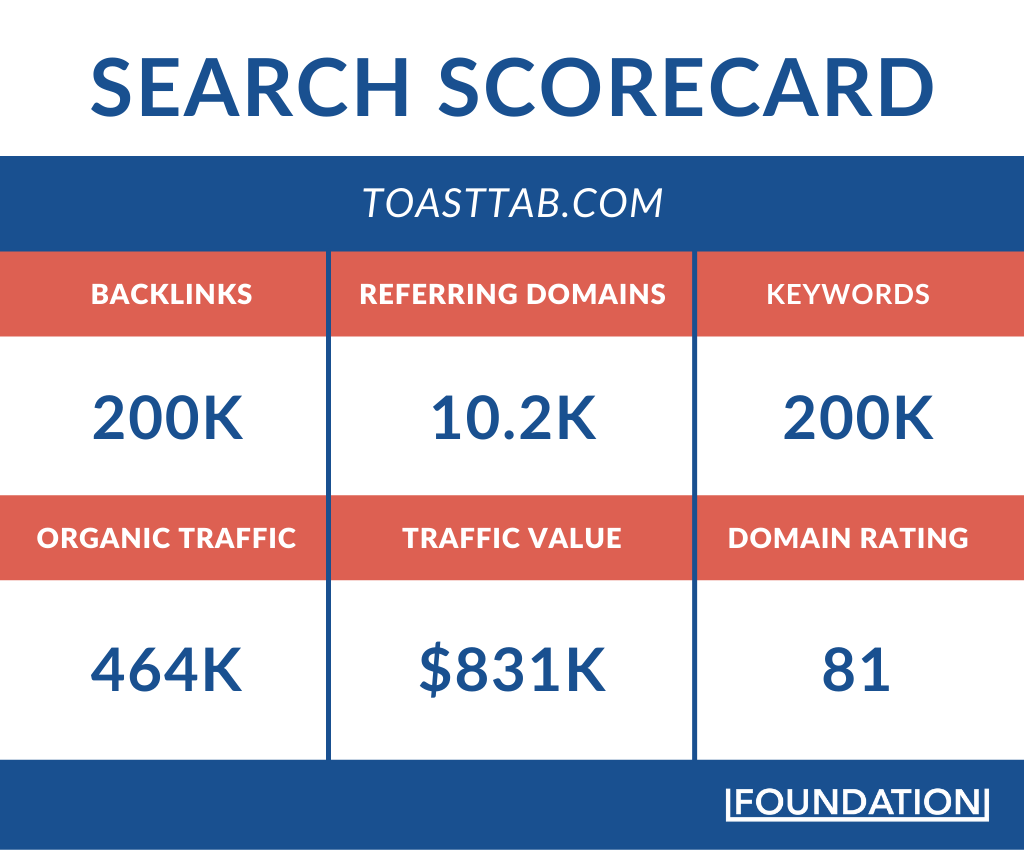
Toast is All-in on Organic Growth
One of the most interesting things about Toast’s growth strategy is that it’s largely reliant on organic traffic.
Based on data from SimilarWeb, organic traffic is the crux of Toast’s strategy. Right now, 55% of site visits come through search and another large chunk comes from direct traffic.
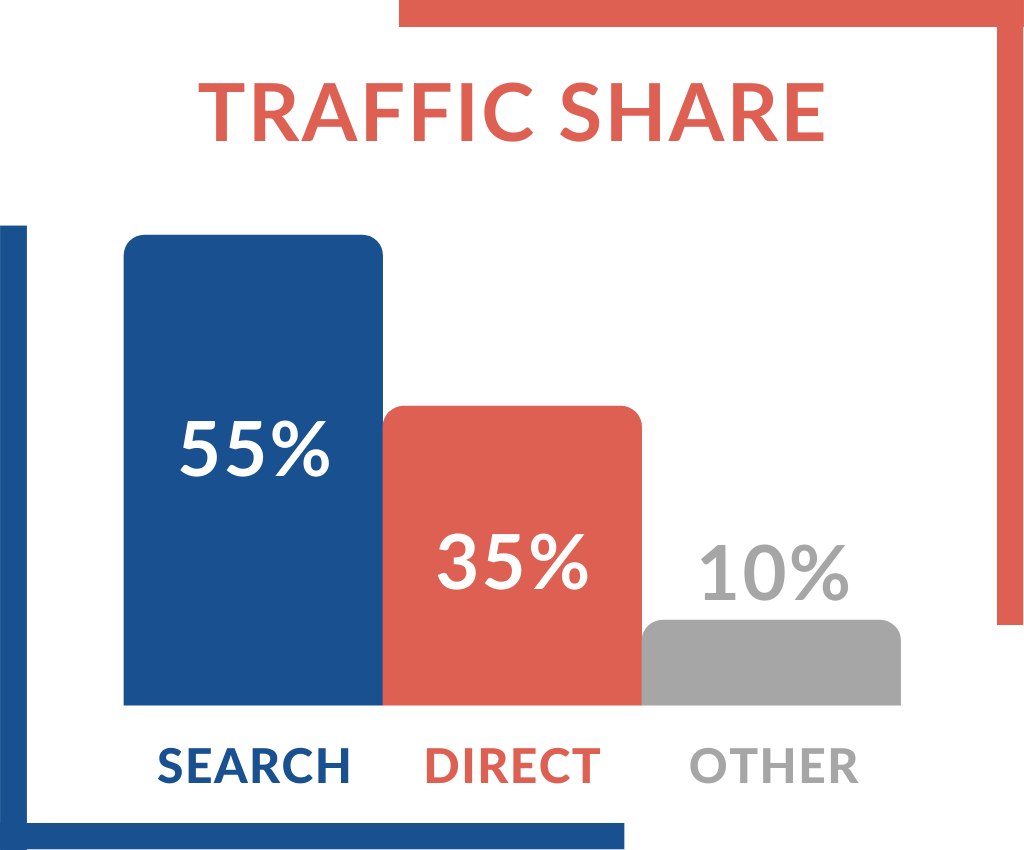
This means other digital marketing mainstays like email, social, PPC, and referrals only make up a small sliver of the overall pie.
Toast’s reliance on organic traffic is a full 25% greater than the rest of the companies in the Restaurant and Delivery space.
They’ve created a massive SEO moat using hospitality-relevant keywords, but more on that later.
Their content strategy is also a major reason why the company is generating more search traffic than competitors like TouchBistro, HungerRush, and Lightspeed.
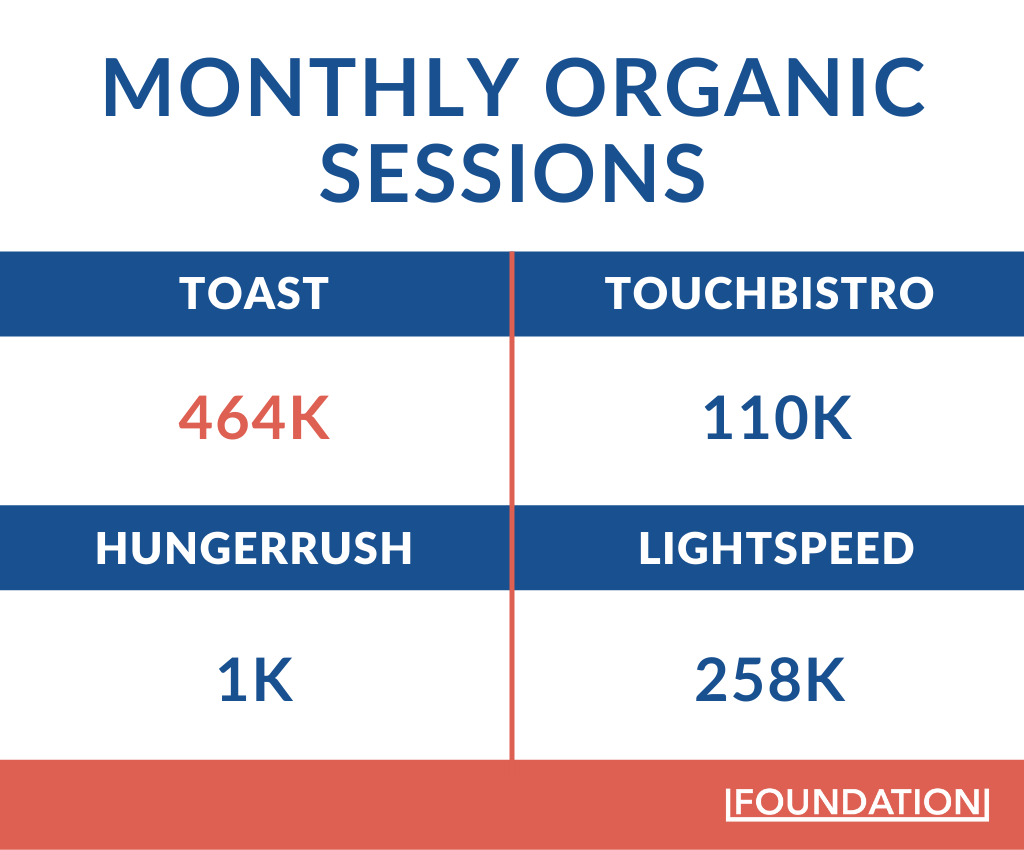
Currently, the site pulls in 464k visitors a month through search. That’s a 100% increase on what their traffic was this time two years ago when it clocked in at 220k.
Considering the company was founded in 2011 and has a fairly established presence, I was curious to see why their organic traffic ascent overlapped with one of the most difficult economic times for restaurants.
Then I found their secret weapon:
On the Line, a publication from Toast.
50% of Its Traffic Comes From Thought Leadership Content

Hidden within the Learn section on the Toast homepage, this sub-folder sits next to other content stores like Resources, Free Tools, Compare, Customer Stories, and Customer Care.
But, unlike the rest, On the Line generates about half of Toast’s organic traffic!
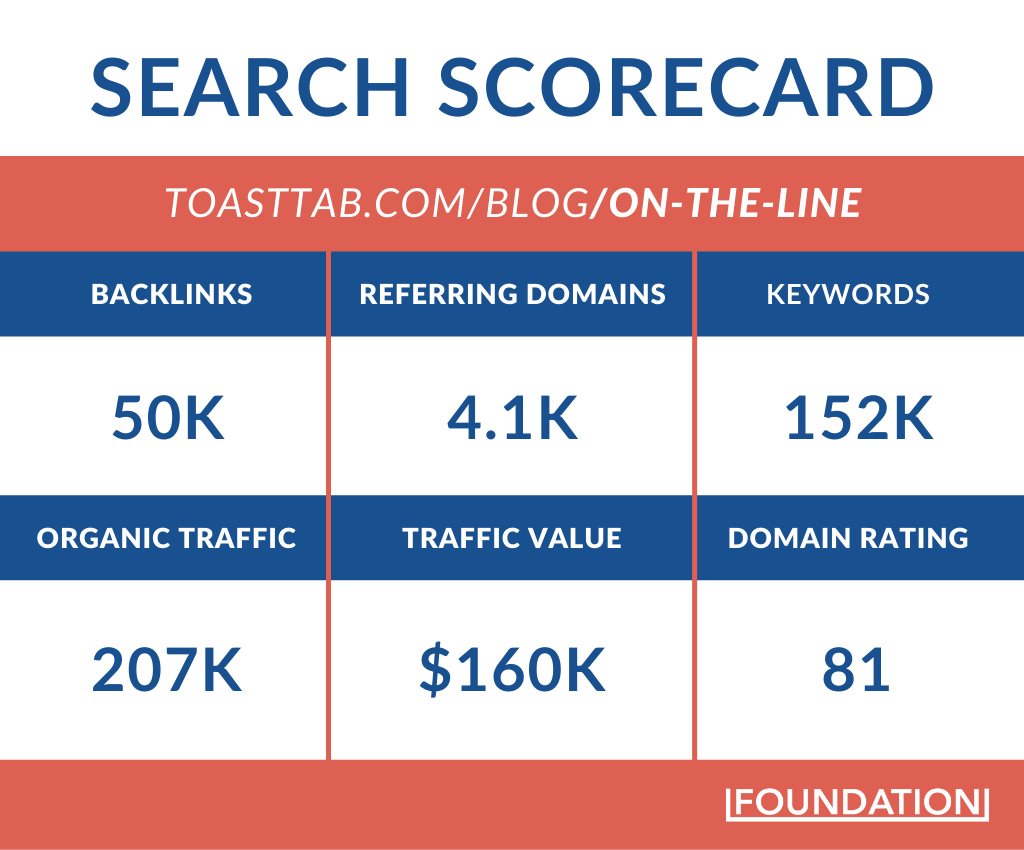
Initiated in late October of 2019, On the Line is “a publication for restaurant people.” It covers everything from real-life stories about scrappy restaurateurs from marginalized communities to practical advice about floorplans, menu design, and staff retention.
It’s the digital format in which to build up a content ecosystem, and it didn’t take long for Toast to reap the rewards. Just take a look at the OTL traffic yourself.
From the rollout date to about mid-May of 2020, the publication experienced some solid growth to the tune of about 14k organic visits.
And then the traffic explodes.
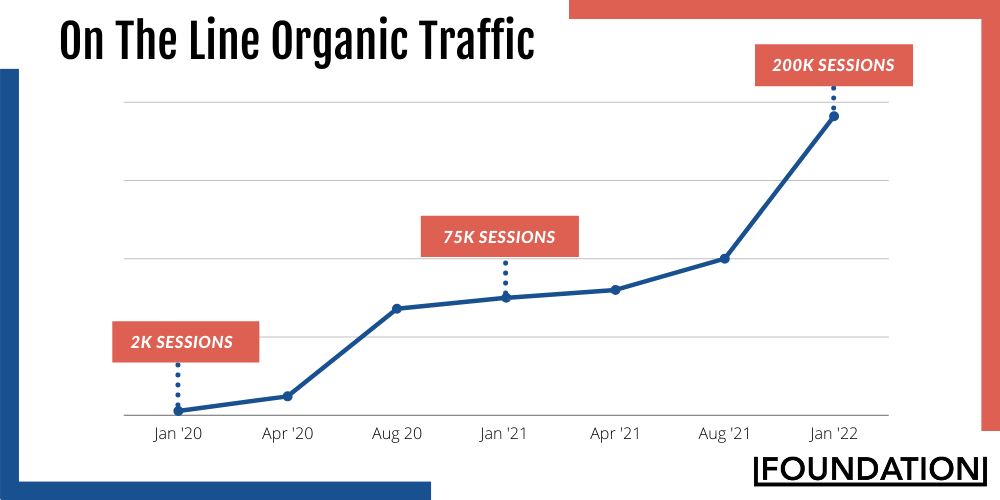
The summer months of 2020 see OTL traffic increase rapidly to over 75K by September — a 435% increase since May!
And remember, this is all happening during the major disruption of COVID’s 1st and 2nd waves, with restaurants being a primary economic casualty of lockdowns.
How was this POS platform raking in traffic while restaurants were struggling to stay afloat?
Toast is EATing Up Leads with On the Line
On the Line serves a few crucial functions for Toast as a B2B SaaS company, not the least of which is dramatically expanding the top of their sales funnel by helping the site rank for a broad category of keywords.
On the Line is Toast’s SEO moat.
Let’s take a look at Toasts’ keyword ranking metrics since the rollout of On the Line in late 2019.
Right around the time traffic was spiking for Toast’s publication, the number of total organic keywords the site ranks for increased from 25k to 92k — an increase of 360%.
What’s even more interesting is that the majority of this increase occurred in the sub 10 SERP position range. Basically, Toast created lots of keyword-rich content that did not make it to the front page of Google (at least initially).
Here are some of the keywords that illustrate the point:
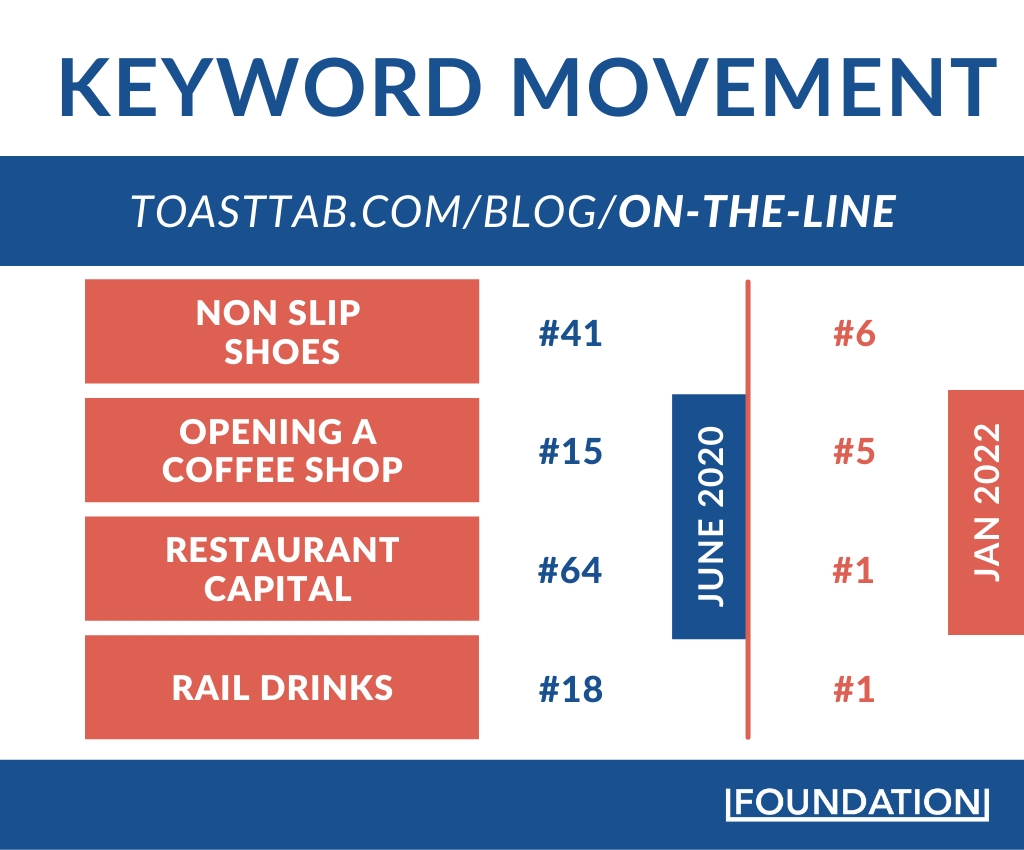
Let’s take a look at the first keyword on the list, “non slip shoes,” from a risk perspective. By creating this post, Toast is competing against prominent retailers like Walmart, Amazon, and Target.
Ditto for modified versions like “best non slip shoes,” where they are competing against prominent review sites like Wirecutter.
In isolation, this is a very risky approach. But Toast is repeating the strategy thousands of times to mitigate the downside — even if it means dipping into keywords that seem outside of their industry.
This scatter-shot approach typically isn’t one that B2B marketers look favorably on, but at Foundation Labs we love ourselves a good SEO moat.
It’s like Toast is making tens of thousands of micro-investments in hospitality-relevant (and adjacent) keywords; eventually, some of them are going to hit big. And, as of January 2022, it’s pretty obvious that many have.
On the Line isn’t just targeting restaurant owners, it’s targeting the entire hospitality ecosystem. Up, down, and across the chain of command.
That’s why their tagline is so fitting: “A publication for restaurant people.”
A quick look at top-performing Toast pages shows exactly this as well.
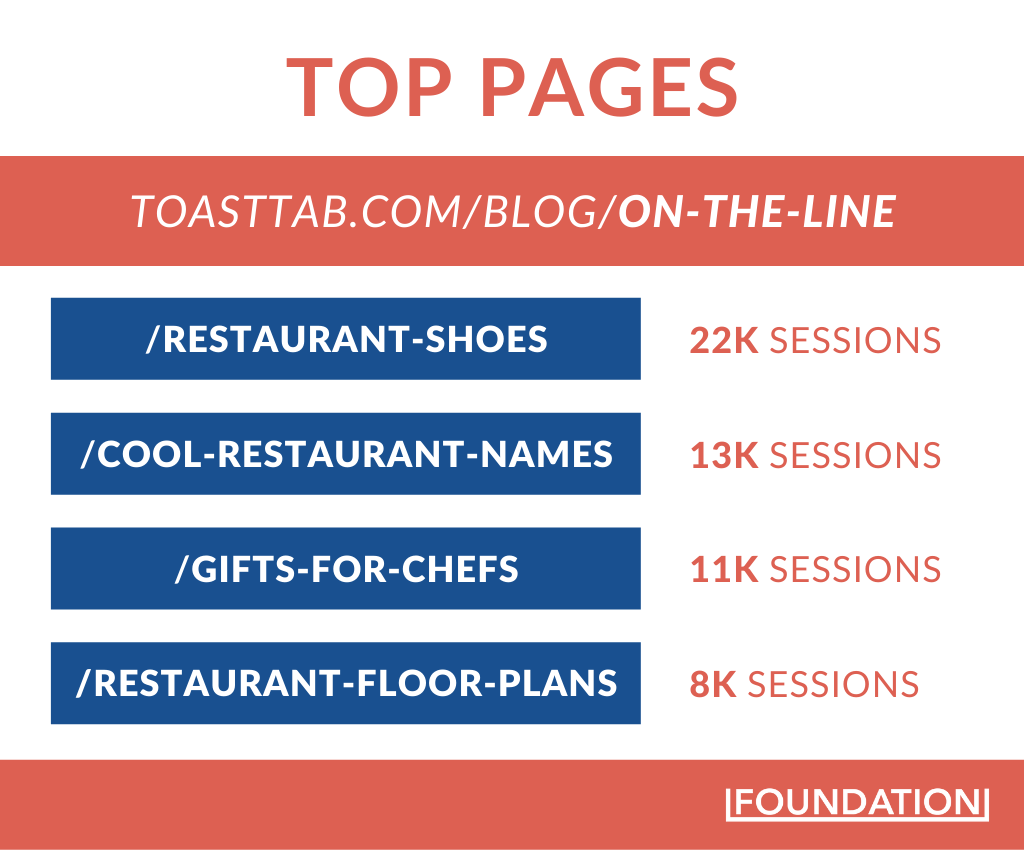
The top page, big surprise, is the Toast homepage.
But the next four pages after that are all from the /on-the-line/ sub-folder. And the topics aren’t exactly one logical thought away from “I should check out this restaurant POS and management software.”
Let’s take number 2 overall, an On the Line post titled “The 14 Best Non-Slip Restaurant Shoes.” Generating nearly 10,000 more visits per month than the next most popular page, this post simply lists the best footwear for hospitality staff looking to stay safe on the job.
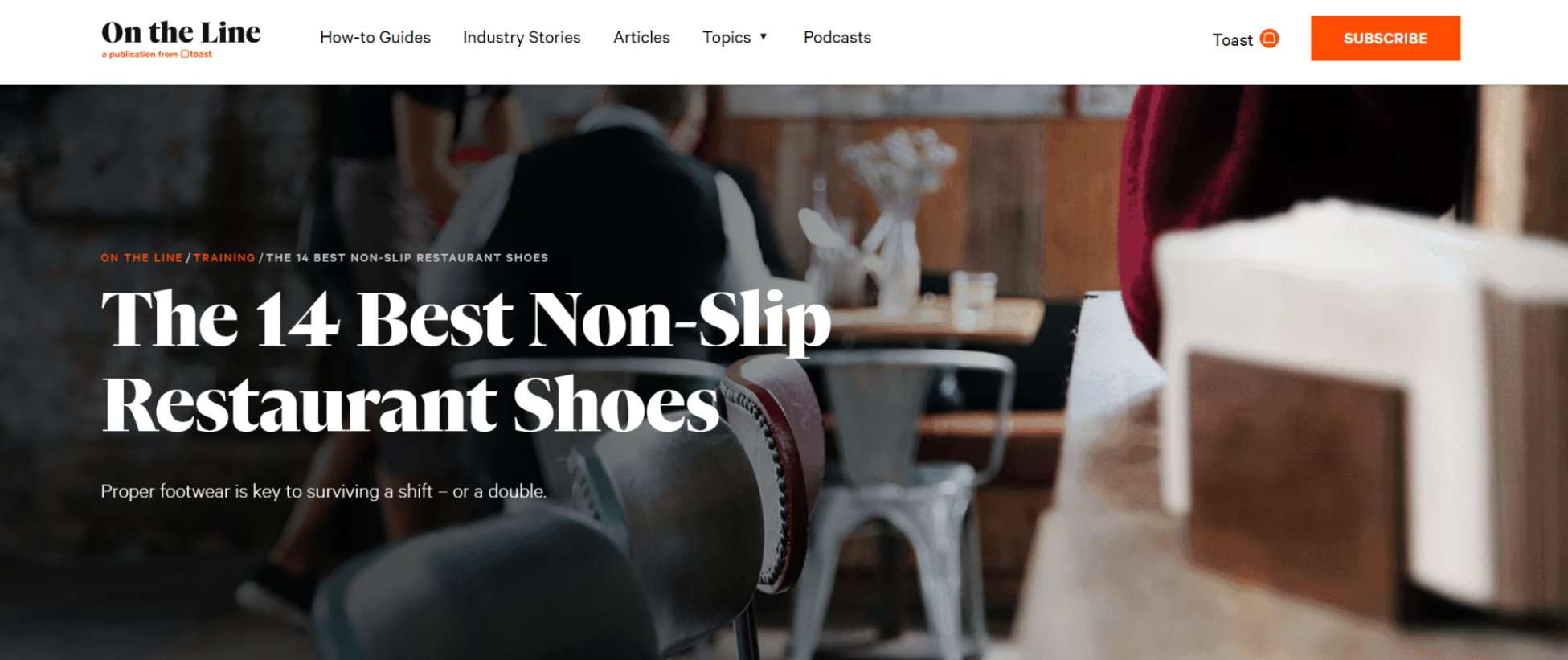
Here’s another one, “How to Choose the Right Restaurant Name (+ 118 Great Ideas & Examples).” At just over 12,000 views per month, this article is quietly very effective, primarily because it allows Toast to target the entire umbrella of restaurant name–related keywords.
Basically, any iteration of “Best [insert specific cuisine/country] Restaurant Names” is captured in this article.
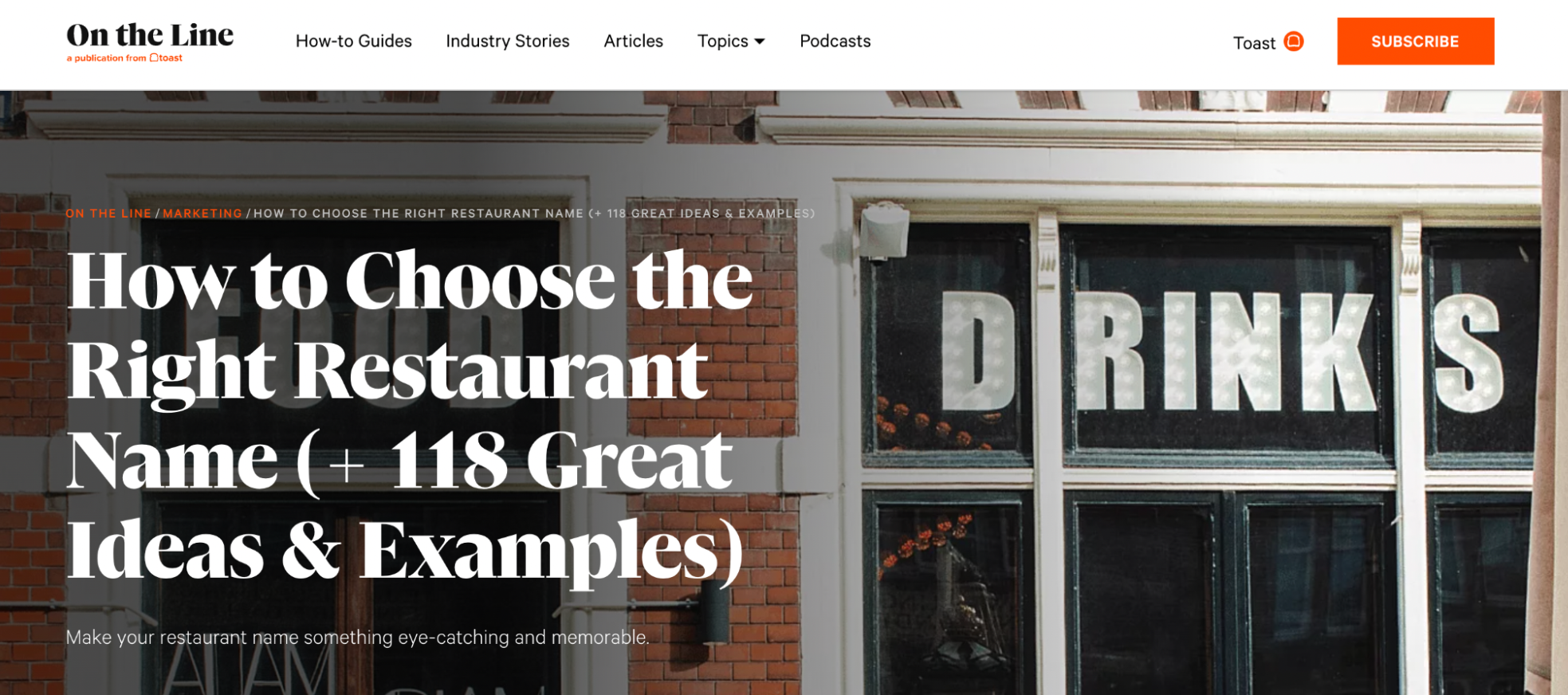
Or, how about “How to Design a Restaurant Floor Plan, Layout and Blueprint.” The post brings in nearly 8,000 organic visits a month, ranks within the top 100 SERP results for 3,200 keywords, and has the second SERP position for “restaurant plan.”
Three of Toast’s micro-investments just hit, in a big way.
The best part? These posts are relevant to everyone in the service ecosystem — from support staff to line cooks to bartenders and even upper management. Anyone who steps foot in a restaurant to work will gain from reading On the Line’s content.
And like the rest of the content On the Line publishes, it also helps Toast turn interested parties and casual browsers into qualified leads.
From On the Line to Down the Funnel
Toast designed its online publication so readers can filter the content by topic, including:
- Training
- Hiring
- Retention
- Industry News
- Operations
- Menu + Food
- Marketing
- Accounting
By expanding its content to cover a range of different topics, Toast is creating multiple hubs of content. Each of these is like a different index of keywords for Toast to invest in, keywords that grab the attention of any and all hospitality professionals.
“Content hubs are an important part of an effective SEO strategy for several reasons. First, they demonstrate to Google that your website is an authority on a given subject. This can help you to rank higher in search results. Second, content hubs provide an opportunity for effective internal linking. By linking to related articles within a content hub, you can help visitors find the information they need while also keeping them engaged with your website. Finally, content hubs have a high impact on engagement metrics such as time spent on-page. By providing visitors with a wealth of relevant and well-organized information, you can encourage them to stick around longer, which can lead to better conversion rates.” – Houssam Rihane, content and marketing manager at USA POS System
Just take a look at some of the keywords that Toast ranks for:
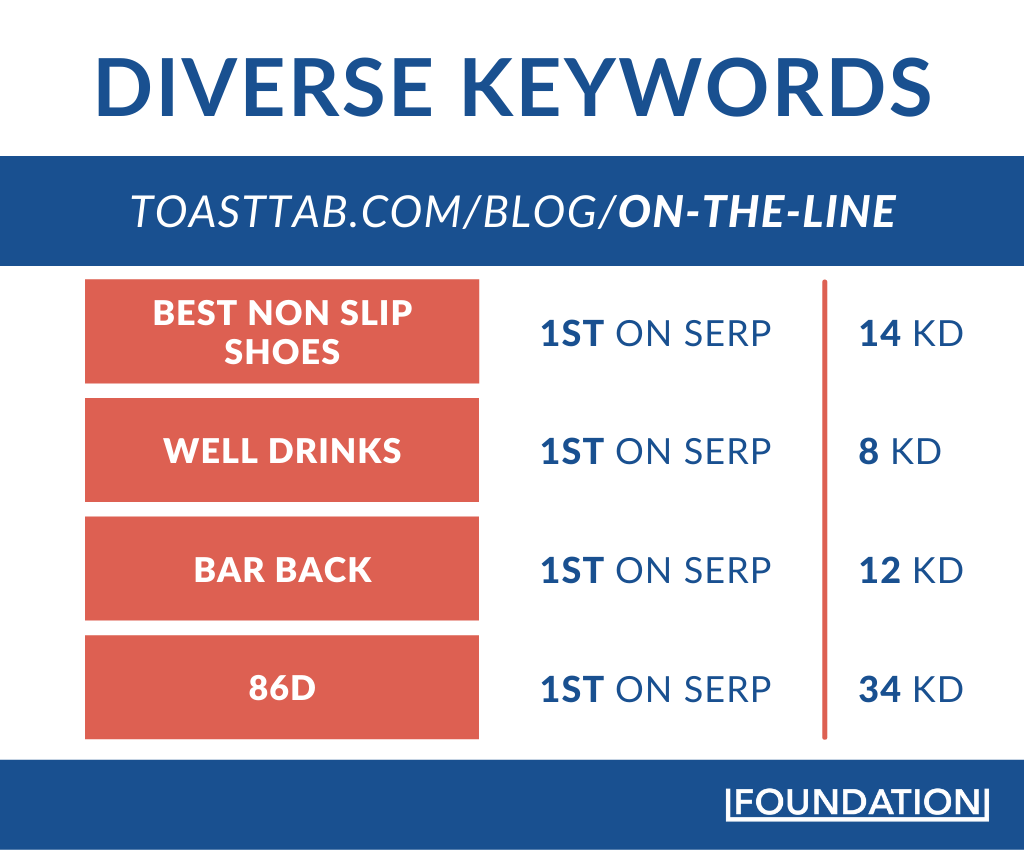
By targeting a larger ecosystem of keywords, the in-house publication allows Toast to expand the top of their funnel and attract a wider pool of potential leads. From there, the Toast marketing team uses the strategic placement of links to internal blog posts, free resources, and email sign-ups.
Let’s take another look at their most-visited On the Line post.

Again, it’s worth noting that Toast is selling tech services, not retail garments. The popularity of this post simply illustrates how Toast’s On the Line content strategy is paying off.
Throughout this listicle piece, Toast includes links, email signups, and prompts to consume other pieces of content that begin the lead-capture process.
The company begins qualifying leads by promoting resources that are relevant to restaurant staff with decision-making responsibilities within the business.
The gatekeepers.
Here are a few of the lead-capture resources used within the post:
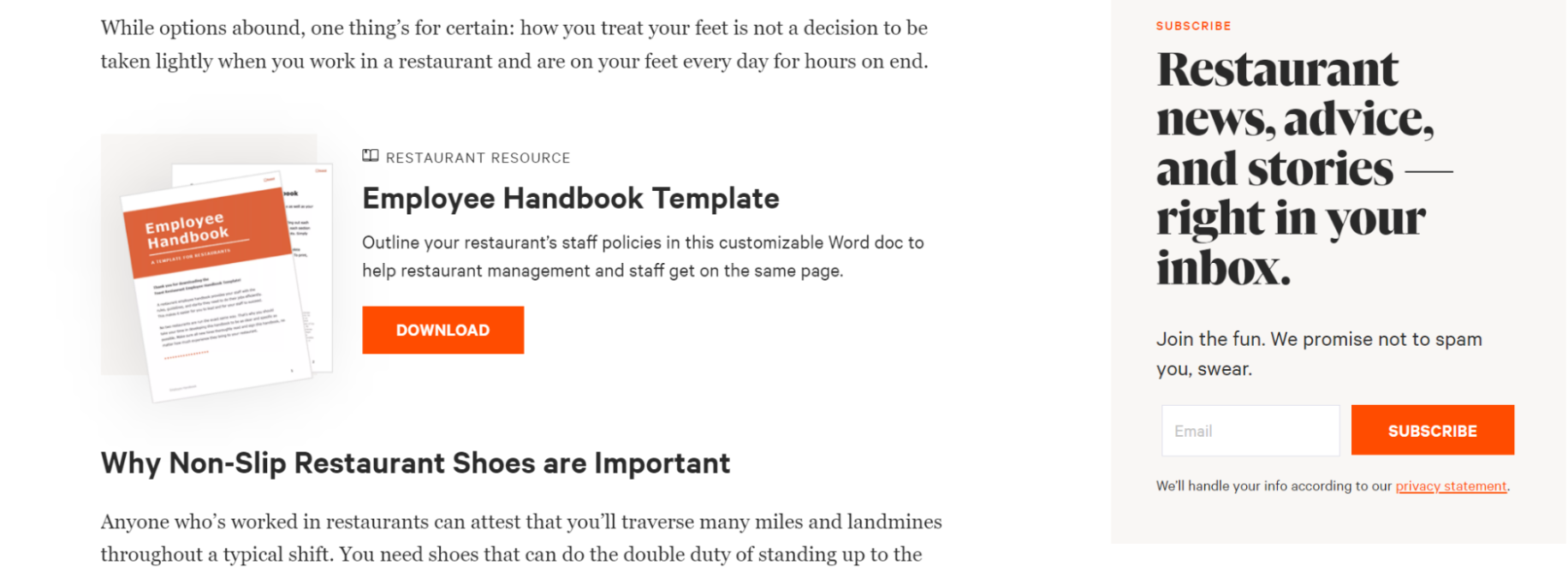
The same strategy is present in practically everything that Toast publishes through On the Line. If we take another look at the “How to Design a Restaurant Floorplan, Layout and Blueprint” post, potential leads are exposed to three additional template resources — one each for floorplans, layouts, and blueprints.
These interested parties can then download each of them after submitting primary contact information.
I’m also struck by how straightforward, non-intrusive, and user-friendly these lead captures are. They even allow visitors to stay at their exact spot on the post so they can continue reading after downloading.

Whether it’s premium content behind a contact form, a downloadable template, or a subscription to the email list, each additional resource moves leads farther down the acquisition funnel.
While the aim and style of the content might change, each of the topic hubs within the On the Line publication is designed to provide value while also moving readers into their subscriber list.
From top-of-the-funnel articles about non-slip footwear and industry lingo to internal aggregator posts about restaurant email marketing and COVID guidelines, On the Line effectively drives traffic.
But that’s not all.
Driving Culture in the Restaurant Space
Toast is also driving culture with the On The Line publications.
I’m a sucker for stories. So naturally, when I came across the Industry Stories section of On the Line’s main menu, I had to check it out.
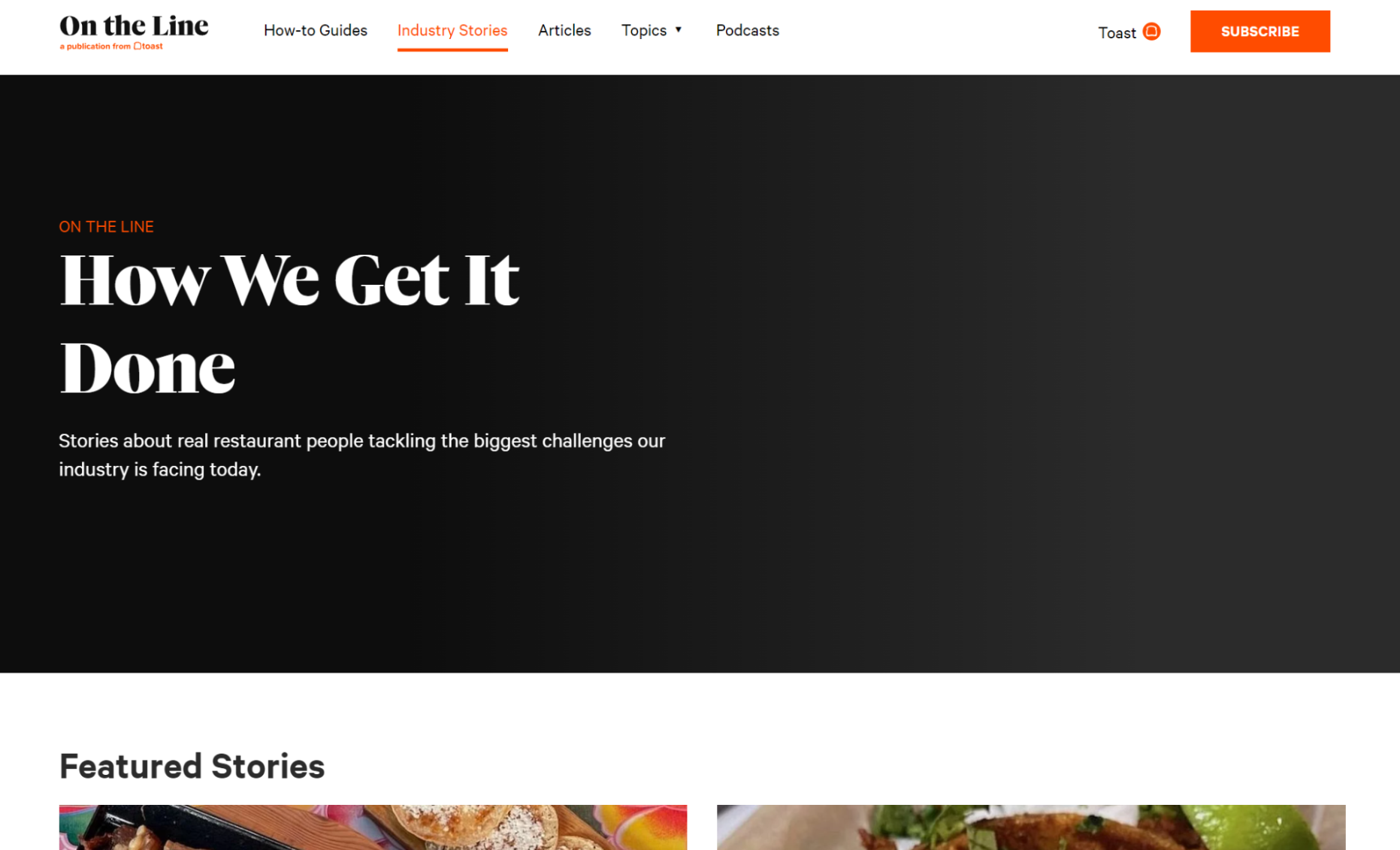
What I found was another dimension to Toast’s publication. One that serves to engrain this tech company within the restaurant community on a cultural level.
It’s clear that Toast has its content marketing, SEO, and acquisition funnel working together like a well-oiled machine. But to boost their publication bona fides even further, Toast uses On the Line to do some good old-fashioned food journalism.
From stories about staple grills in Tokyo to highlighting black brewers and chefs to strategies for offering employee benefits during tough times, On the Line is highlighting the restaurant stories that deserve to be told.
These stories often center around the front-line workers and marginalized communities that are frequently excluded despite their major contributions to the industry.
It’s a style of content that improves Toast’s expertise, authority, and trustworthiness (collectively known as EAT) rating by showing that they are dedicated to helping restaurateurs with both their SaaS and their influence in the hospitality space.
Of course, it doesn’t hurt from an SEO perspective either — here’s one last example.

The most popular Industry Story on On the Line is about a Restaurant called Slutty Vegan. According to Google Trends, this growing vegan restaurant chain experienced a massive bump in search queries in late June 2020, around the time of a Juneteenth collaboration with Chris Paul and other prominent celebrities.
So, in addition to covering an inspiring, culture-shifting story for their readers, Toast is also able to capitalize on timely, boutique keywords and bring even more visitors into their expansive acquisition funnel. It’s a true win-win for Toast and the hospitality industry.
The Bottom Line for “On the Line”
Toast’s decision to distribute content publication-style is clearly paying off.
It’s helping them gain SERP dominance over an entire ecosystem of restaurant-related keywords and provides them with significantly more organic traffic than their competitors. And, as we’ve seen, organic traffic is crucial for any company looking to stand apart in the era of SaaS commoditization.
But that’s not all.
On the Line also provides B2B marketers with a shining example of how strategic content investment pays dividends, even in the toughest economic times.
It allows Toast to target the entire hospitality industry with their content, not just the decision-makers at the top.
And this wider network of visitors can then be qualified more accurately as they travel down topic-specific sales funnels.
Regardless of the industry in question, investing in a strong SEO moat is undoubtedly the right strategy for forward-thinking companies looking to achieve long-term growth. Just ask Toast.
Written by Guest Contributor Ethan Crump.







